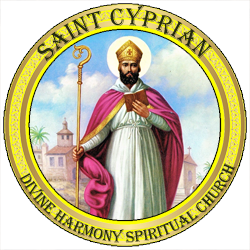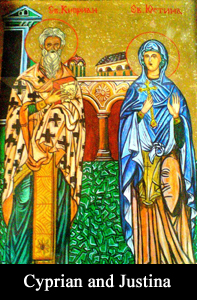 Saint Cyprian of Antioch is an extremely interesting individual who is beginning to enjoy a resurgence in popularity. Often mistakenly conflated with St. Cyprian of Carthage, it can sometimes be difficult to separate the two as both were martyrs and both were bishops who were born in Carthage sometime in the 3rd century. Many believe the common images used for Saint Cyprian of Antioch are actually derived from representations of St. Cyprian of Carthage.
Saint Cyprian of Antioch is an extremely interesting individual who is beginning to enjoy a resurgence in popularity. Often mistakenly conflated with St. Cyprian of Carthage, it can sometimes be difficult to separate the two as both were martyrs and both were bishops who were born in Carthage sometime in the 3rd century. Many believe the common images used for Saint Cyprian of Antioch are actually derived from representations of St. Cyprian of Carthage.
Cyprian of Antioch was said to have been born in Carthage as a pagan child dedicated to the service of Apollo. By the age of ten he was already a noted practitioner of divination, and was said to be able to interpret many signs such as the sound of winds through the trees, the movements of animals, and also was able to hear the whispers of the dead. At the age of fifteen he was living in Sparta, where his connection to the underworld was strengthened even further when he was taught ancient incantations on how to directly commune with the dead. He moved on to Memphis, Egypt at the age of twenty where he learned the ways of possession and demonology, and some say his mastery in this area eventually rivaled the Great Solomon. By the time he was in his thirties, he was renowned as a great sorcerer and master of astrology, demonology, conjuring, necromancy, herbology, and many other areas of magic.
 He eventually moved to Antioch where he became known for his philosophical musings and as a powerful sorcerer. As the legend goes, one day a young man named Aglaidas came to seek his services as a conjurer, to win the love of a beautiful Christian virgin named Justina. Cyprian worked his magic, but was unsuccessful in turning her will. Justina’s faith in god was resolute, and through her diligent prayers she was immune to Cyprus' works. Cyprian continued his attempts, even resorting to setting demons loose on Justina, but all of these efforts were also exhausted without result. Some versions of the tale say that upon seeing this, Satan himself became angry and tried to carry out the assignment, but after Justina made the sign of the cross, his efforts were also in vain. These events, along with her eventual martyrdom, have given cause for Justina to be venerated in many churches.
He eventually moved to Antioch where he became known for his philosophical musings and as a powerful sorcerer. As the legend goes, one day a young man named Aglaidas came to seek his services as a conjurer, to win the love of a beautiful Christian virgin named Justina. Cyprian worked his magic, but was unsuccessful in turning her will. Justina’s faith in god was resolute, and through her diligent prayers she was immune to Cyprus' works. Cyprian continued his attempts, even resorting to setting demons loose on Justina, but all of these efforts were also exhausted without result. Some versions of the tale say that upon seeing this, Satan himself became angry and tried to carry out the assignment, but after Justina made the sign of the cross, his efforts were also in vain. These events, along with her eventual martyrdom, have given cause for Justina to be venerated in many churches.
Confused about the ineffectiveness of his magic, the exhausted Cyprian went to Justina to understand the source of her immunity. Upon observing her unshakable faith, he was moved to convert to Christianity himself. He begged God for forgiveness and mercy, which was given. Some say Cyprian's conversion was a ruse, done so that he might continue practicing his magic while avoiding increasing persecution from the church (hiding in plain sight). Whatever the case, after converting to Christianity, he was able to rise upward through the hierarchy and eventually became the Bishop of Antioch. He has since become a kindred spirit for those who work in the magical arts but also find their spiritual home in the church.
During Roman Emperor Diocletianic's famous "Great Persecution" of Christians, Cyprian was turned over by the people to the Roman governor of the region, where he would be judged for shaming their gods and turning people away from them. Both Justina and Cyprian refused to renounce their faith, and were sentenced to be tortured by being thrown in a boiling cauldron. This was done, but no harm came to them. Enraged and also fearing the legendary sorcery of Cyprian, the governor sent Cyprian and Justina to Nicomedia were they both again refused to renounce their faith. They were both successfully beheaded on the bank of the river Gallus, in 303 AD. It is said that seeing Cyprian and Justina's unshakable faith caused a Roman named Theoctistus to announce suddenly that he himself was a Christian, and he also was beheaded. Their bodies laid unburied for six days, finally being taken by Christian sailors to Rome, where they were interred on the estate of a noble lady named Rufina and later were entombed in Constantine's basilica.
Today Cyprian is remembered for his unique mixture of ancient magic and Christianity. His ability to adapt himself and thrive between differing spiritual ideologies is a great example to many. As the patron saint of necromancers, he serves as a bridge between religious factions that too often find themselves in conflict.

